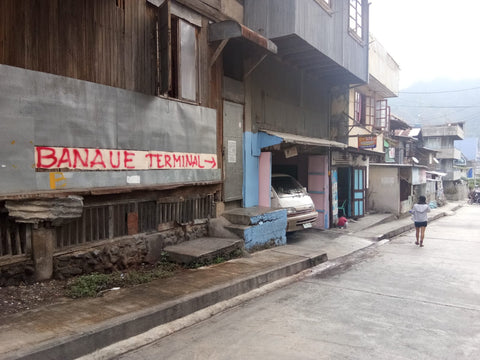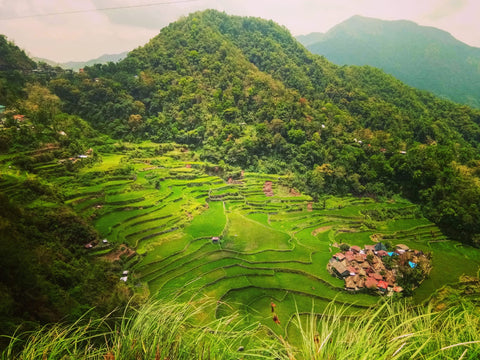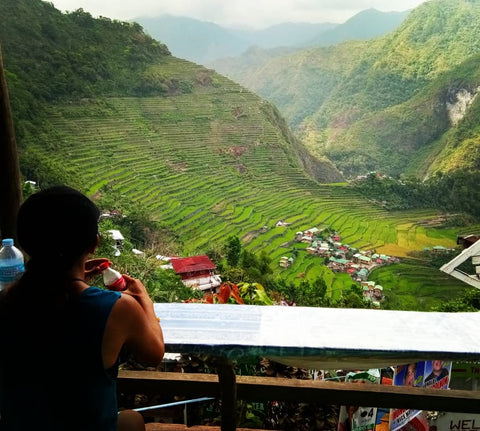
Photo by: China D @projectgoals.ph
It’s a destination that can be found on just about everyone’s travel wish list, Filipino and foreigner alike, a must see before time renders the retinas incapable of doing just that. As its aesthetic beauty is equal to its incredibly practical qualities, the Filipino government used its image on another pretty practical commodity – the 20 peso bank note. If you haven’t already, you too should put seeing this place, the incredible feat of engineering and most sublime example of man using the natural contortions of Mother Nature in the Philippines, on your travel list – the Banaue Rice Terraces.


Photo by: China D @projectgoals.ph
The Banaue Rice Terraces are located in the Cordilleras of Luzon island, 260kms as the crows flies, north of the capital Manila. One of the first things you’ll notice as you traverse the steep mountains either by van or local tricycle, is that large chunks of the mountainous terrain appear wildly cultivated. This is because there are in fact a vast expanse of terraces located in several villages, and collectively they are known as the Banaue Rice Terraces. As you pass through mist lingering on the road, you will see entire mountains in pixilation with row upon row of rice terrace stepping its way up the cliff side. The surrounding unpixelated clouds and trees helpfully send a signal to your brain that reminds you - this is not Minecraft, this is real!
So amazing is the achievement of the local Ifugao people in growing vast amounts of rice without the use of a field, the terraces were designated as a UNESCO World Heritage site in 1995. Considering they were created more than 2,000 years ago, it took UNESCO long enough – and they say the locals are on “Filipino time”!

After an hour jeepney ride from Sagada, we arrived in Bontoc. From there we made our way on foot following the handcrafted signpost to the terminal in order to catch a van to Banaue. In Banaue village, it was no trouble finding a tricycle driver. In fact, it's like they're forming a welcoming party where the vans pull in. We chose one who's jib we liked the cut of and arranged to use his services for the whole day. He drove us and our luggage, skilfully strapped to the top of the sidecar (the luggage, not us), to Bangaan Ifugao Rice Terraces.

Photo by: China D @projectgoals.ph
It is here, from the height of the road on the mountain side, that you can look down on to the small village of the Ifugao people, nestled in a valley of surrounding rice terraces. It is a mass of hand made buildings, tightly clumped together and only accessible by foot. To gaze upon it is like looking into the distant past. Stories told by our knowledgable tricycle driver, of warring tribes fighting over things long since settled, further immersed us in another time.

Photo by: China D @projectgoals.ph
Back in the tricycle, we wound our way around the mountains to the Batad portion of the rice terraces. Everything was clenched in the sidecar as the squeal of the brakes had us hoping they weren’t due for replacing that day. At one point, our driver stopped in order to redistribute some weight. He put me on the back of his motorbike and left my lighter partner in the sidecar as a counterweight. With that sorted, the wind in my hair and my flip flops centimetres from the spokes, we drove down to a parking station (clearing on the road) where we went the rest of the way on foot with a designated guide to walk amongst the green, infant rice.

To get the most literal breath-taking views, we climbed up the cliff side, through the terraces, on paths narrower than a person’s foot and up bamboo ladders. Our flip flops actually aided our climb because we could grip with our feet. Anything rubber and comfortable will be your best bet. The steep trek is absolutely worth the incredible view at the top. There are a few facilities located at the entrance and at the end of the trek where you can purchase refreshments to re-fuel.



Photo by: China D @projectgoals.ph
Our tricycle driver was waiting for us after our trek. He’d even taken great care of a small purple chilli plant we’d bought in Baguio because we liked the colour. It’s a rare colour and we were told that the other tricycle drivers had their wandering eyes on it, so we appreciated his efforts.
Once up the steep mountain, I was allowed back in the sidecar and our driver graciously drove us to his family home for lunch. We were fed rice and masarap na pinakbet cooked by his wife. As we ate we were entertained by his charming toddling son. We quenched our thirst with natural spring water that was redirected for use in the house. His humble home was a reminder of what is really important in this life, and it's not the latest gadgets or a house so big you don't have to run into any family members if you choose. It's about keeping it simple materialistically and going all out, total immersion if possible, with what nature provides. No, it was not his house but the people inside and the vivid green surroundings which surely made the place worth millions. As for our experience of the Banaue Rice Terraces - priceless.
Project Goals Recommends:
-
The best time to see the rice terraces is April to May and October to November, just before harvesting when the mountains are vivid green with fresh rice.
-
To see the rice terraces in a day, buses run from Sagada or Baguio to Bontoc daily - be sure to leave early in the morning. From Bontoc, pay for a seat in a van running from the Banaue Terminal. There are no set times with the van, it leaves once it is full.
-
If travelling from Manila, an overnight bus service runs directly from Manila to Banaue.
-
There is an entrance fee at the Batad Rice Terraces of around 400 pesos, this pays for a tour guide to walk you through and is compulsory.
-
Be sure to carry cash. ATMs are few and far between in this part of the Philippines. The only one we could find was in Bontoc before leaving for Banaue.
